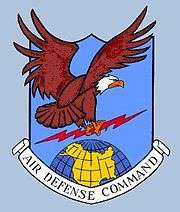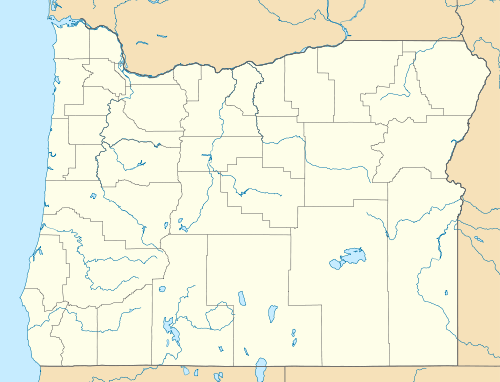Baker Air Force Station
Baker Air Force Station | |
|---|---|
| Part of Air Defense Command (ADC) | |
 Baker AFS Location of Baker AFS, Oregon | |
| Coordinates | 44°35′11″N 117°47′14″W / 44.58639°N 117.78722°W |
| Type | Air Force Station |
| Code | ADC ID: SM-149, NORAD ID: Z-149 |
| Site information | |
| Controlled by |
|
| Site history | |
| Built | 1959, 57 years ago |
| Built by |
George A. Moore and Assoc., Inc. Portland, Oregon[1] |
| In use | 1959–1968 |
| Battles/wars | Cold War |
| Garrison information | |
| Garrison |
821st Aircraft Control and Warning Squadron |

Baker Air Force Station was general surveillance radar station in the western United States, in the high desert of eastern Oregon. Located on Beaver Mountain south of Baker City, it was operated for less than a decade be the U.S. Air Force and closed 48 years ago in 1968.[2]
Baker AFS was initially part of Phase II of the Air Defense Command Mobile Radar program. The Air Force approved this expansion of the Mobile Radar program on October 23, 1952. Radars in this network were designated "SM."
History
Located 13.4 miles (21.6 km) south of Baker City, the station became operational 57 years ago in 1959 when the 821st Aircraft Control and Warning Squadron was moved to Baker AFS in July. The squadron began operating an AN/FPS-35 search radar and an AN/FPS-6 height-finder radar, and initially the station functioned as a Ground-Control Intercept (GCI) and warning station. As a GCI station, the squadron's role was to guide interceptor aircraft toward unidentified intruders picked up on the unit's radar scopes. Baker AFS had the only AN/FPS-35 enclosed by a radome, constructed in 1963. The summit of Beaver Mountain exceeds 6,300 feet (1,920 m) above sea level, nearly 3,000 feet (910 m) higher than Baker City.
During 1960, Baker AFS joined the Semi Automatic Ground Environment (SAGE) system, feeding data to DC-16 at Stead AFB, near Reno, Nevada. After joining, the squadron was redesignated as the 821st Radar Squadron (SAGE) on 15 October 1960. The radar squadron provided information 24/7 the SAGE Direction Center where it was analyzed to determine range, direction altitude speed and whether or not aircraft were friendly or hostile. On 31 July 1963, the site was redesignated as NORAD ID Z-149.
In 1964 an AN/FPS-6A height-finder was added and the AN/FPS-6 was retired in 1966. Operations ceased on 18 June 1968 as a result of budget restrictions and the general phase down of air defense radar stations due to technology advancements. After its closure, the cantonment area in northwest Baker City (44°47′24″N 117°50′38″W / 44.79°N 117.844°W) became the "New Tribes Mission Training Center."[3] The site was offered for sale in 2008 with an asking price of $750,000. To date there has not been much interest due to the asbestos siding on the wood frame constructed buildings. Most of the site remains, the housing area being used for single family homes.
The radar site has been demolished; its AN/FPS-35 radome was moved to Idaho in the early 1970s and became the gymnasium at Payette High School.[4]
Air Force units and assignments
Units
- Constituted as the 821st Aircraft Control and Warning Squadron
- Activated at Geiger Field, Washington on 1 September 1957
- Assigned to Baker AFS on 1 July 1959
- Redesignated 821st Radar Squadron (SAGE) on 15 October 1960
- Discontinued smf inactivated on 18 June 1968
Assignments
- 4700th Air Defense Wing, 1 July 1959
- 25th Air Division, 15 May 1960
- San Francisco Air Defense Sector, 1 July 1960
- Reno Air Defense Sector, 15 September 1960
- 26th Air Division, 25 June 1966 - 18 June 1968
See also
References
![]() This article incorporates public domain material from the Air Force Historical Research Agency website http://www.afhra.af.mil/.
This article incorporates public domain material from the Air Force Historical Research Agency website http://www.afhra.af.mil/.
- ↑ "Low bids revealed on radar projects". Eugene Register-Guard. (Oregon). UPI. June 26, 1959. p. 5A.
- ↑ Jacoby, Jayson (November 11, 2002). "Radar base brought airmen to Baker". Baker City Herald. (Oregon). Retrieved September 13, 2016.
- ↑ Wood, Christina (December 21, 2001). "Some missions begin in Baker City". Baker City Herald. (Oregon). Retrieved September 13, 2016.
- ↑ Hager, Philip (December 26, 1974). "Idaho high school gets its own dome". Spokesman-Review. (Spokane, Washington). (Los Angeles Times). p. 26.
- Cornett, Lloyd H. and Johnson, Mildred W., A Handbook of Aerospace Defense Organization 1946 - 1980, Office of History, Aerospace Defense Center, Peterson AFB, CO (1980).
- Winkler, David F. & Webster, Julie L., Searching the Skies, The Legacy of the United States Cold War Defense Radar Program, US Army Construction Engineering Research Laboratories, Champaign, IL (1997).
- Information for Baker AFS, OR
External links
- Radomes.org – Baker Air Force Station
- State of Oregon - Department of Environmental Quality – Baker Air Force Station
